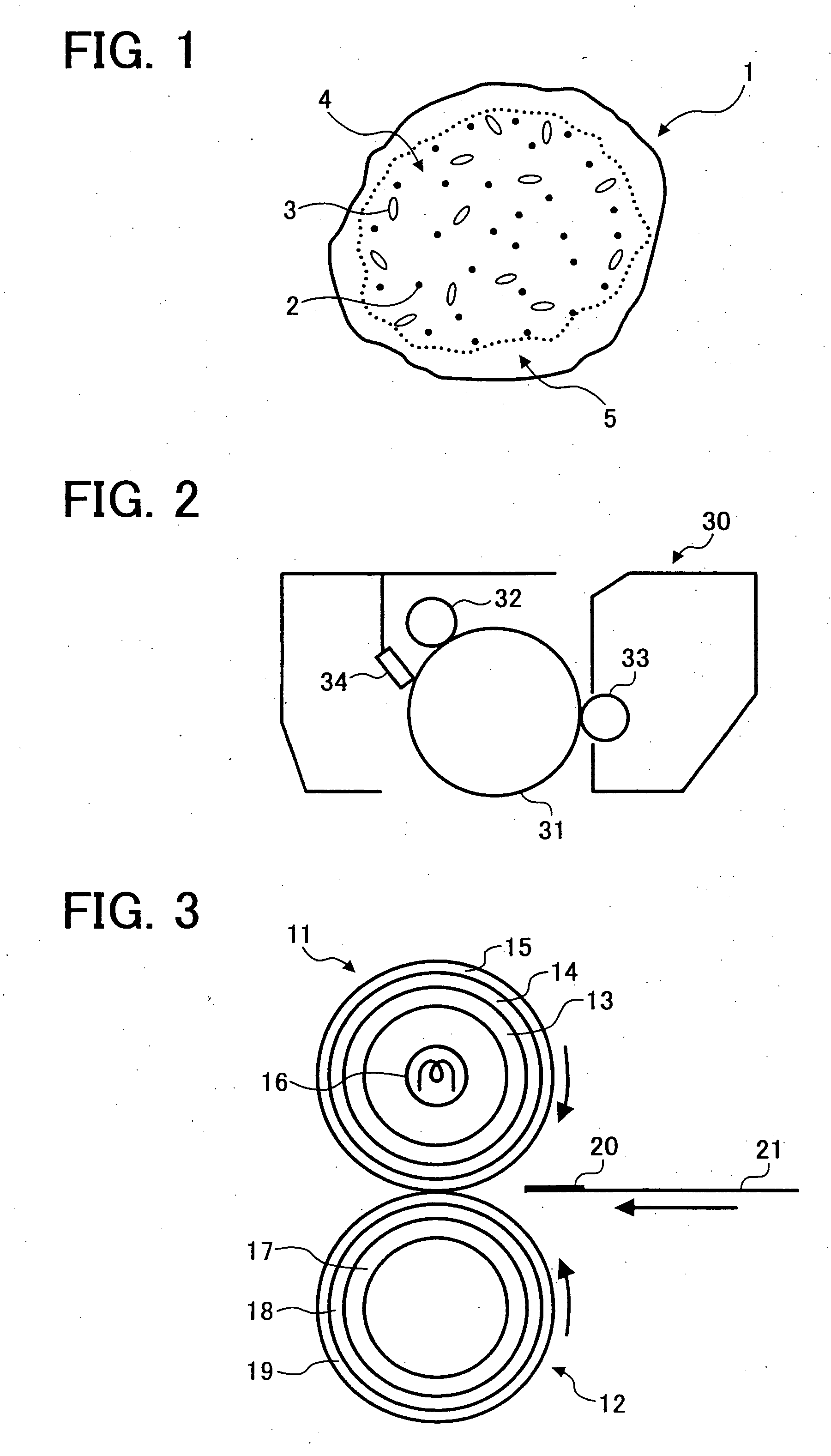Toner, toner manufacturing method, developer, image forming apparatus, and process cartridge for the image forming apparatus
- Summary
- Abstract
- Description
- Claims
- Application Information
AI Technical Summary
Benefits of technology
Problems solved by technology
Method used
Image
Examples
example 1
Preparation of Colorant / Wax Dispersion
[0234] In a reaction vessel equipped with a stirrer and a thermometer, 543.5 parts of the polyester (P-1), 181 parts of a carnauba wax, and 1450 parts of ethyl acetate are mixed and the mixture is heated to 80° C. while agitated. After being heated at 80° C. for 5 hours, the mixture is cooled to 30° C. over 1 hour. Then 500 parts of the master batch (1) and 100 parts of ethyl acetate are added to the vessel, and the mixture is agitated for 1 hour to prepare a raw material dispersion (1).
[0235] Then 1500 parts of the raw material dispersion (1) are subjected to a dispersion treatment using a bead mill (ULTRAVISCOMILL (trademark) from Aimex Co., Ltd.). The dispersing conditions are as follows. [0236] Liquid feeding speed: 1 kg / hour [0237] Peripheral speed of disc: 6 m / sec [0238] Dispersion media: zirconia beads with a diameter of 0.5 mm [0239] Filling factor of beads: 80% by volume [0240] Repeat number of dispersing operation: 3 times (3 passes...
example 2
Preparation of Colorant / Wax Dispersion
[0258] In a reaction vessel equipped with a stirrer and a thermometer, 543.5 parts of the polyester (P-1), 181 parts of a carnauba wax, and 1450 parts of ethyl acetate are mixed and the mixture is heated to 80° C. while agitated. After being heated at 80° C. for 5 hours, the mixture is cooled to 30° C. over 1 hour. Then 500 parts of the master batch (1) and 10 parts of ethyl acetate are added to the vessel, and the mixture is agitated for 1 hour to prepare a raw material dispersion (2).
[0259] Then 1500 parts of the raw material dispersion (2) are subjected to a dispersion treatment using a bead mill (ULTRAVISCOMILL (trademark) from Aimex Co., Ltd.). The dispersing conditions are as follows. [0260] Liquid feeding speed: 1 kg / hour [0261] Peripheral speed of disc: 6 m / sec [0262] Dispersion media: zirconia beads with a diameter of 0.5 mm [0263] Filling factor of beads: 80% by volume [0264] Repeat number of dispersing operation: 3 times (3 passes)...
example 3
Adherence of Particulate Resin
[0273] The dispersion (2) prepared in Example 2 and the dispersion of the particulate vinyl copolymer resin (V-1) prepared above are mixed at a mixing ratio of 1 / 0.2 based on a solid content. The mixture is heated to 73° C. taking 30 minutes.
[0274] A mixture liquid of 100 parts of ion-exchange water and 100 parts of magnesium chloride hexahydrate is gradually added thereto and kept for 5 hours at 73° C. Then pH of the mixture is controlled to be 5 by adding hydrochloric acid. The mixture is heated to 80° C. for 2 hours, and then cooled down. Thus, a dispersion (3-2) is prepared.
[0275] The procedure for preparation of the toner in Example 1 is repeated except the dispersion (1-2) is replaced with the dispersion (3-2). Thus, a toner (3) is prepared.
PUM
 Login to View More
Login to View More Abstract
Description
Claims
Application Information
 Login to View More
Login to View More - R&D
- Intellectual Property
- Life Sciences
- Materials
- Tech Scout
- Unparalleled Data Quality
- Higher Quality Content
- 60% Fewer Hallucinations
Browse by: Latest US Patents, China's latest patents, Technical Efficacy Thesaurus, Application Domain, Technology Topic, Popular Technical Reports.
© 2025 PatSnap. All rights reserved.Legal|Privacy policy|Modern Slavery Act Transparency Statement|Sitemap|About US| Contact US: help@patsnap.com


